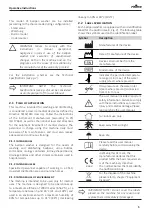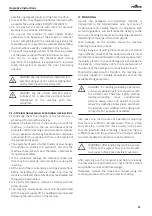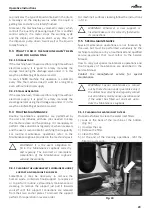
Operative Instructions
15
laboratories, medical practices and environments
connected to the public electricity grid.
The high-frequency (HF) energy emissions of
the machine are so small that interferences with
electrotechnical equipment in the immediate vicinity
are not likely.
The optimal positioning floor must be made of
concrete, wood or ceramic tiles. In case of machine
operation on floors made of synthetic materials,
the relative humidity must be 30% to minimise the
likelihood of electrostatic discharges.
5.2 Water connection
)
CAUTION! The water in the wash chamber is
not drinkable.
The quality of the water used must be compatible with
the manufacturing materials of the machine, with the
chemicals and with the process needs in the various
stages of the procedure.
To have good washing results, the water must be soft
and low in limestone. With hard water white patinas
deposit on the objects to be treated and on the walls of
the wash chamber.
For the correct operation of the machine, the water
inside the washing chamber must have a maximum
hardness of 3.03 mmol/l CaCO
3
(17.80°DH / 30°fH).
If the installation site does not have water with the
required specification, it is necessary to install an
external softener.
The water used in all the washing stages should be
of drinking quality according to the “Guidelines for
drinking-water quality, 4th edition” published by the
WHO. A high iron content can cause rust on the load
and in the special washing machine. If industrial water
contains a higher amount of chlorides than 100 mg/l,
the risk of corrosion significantly increases.
Water hardness conversion table:
French
degrees
[°fH]
CaCO
3
[mmol/l]
German
degrees
[°DH]
CaCO
3
[PPM]
0-10
0-1.01
0-5.60
0-100
11-15
111-1.51
6.16-8.40
110-150
16-20
1.61-2.02
8.96-11.20
160-200
21-25
2.12-2.52 11.76-14.00
210-250
26-30
2.62-3.03 14.56-17.80
260-300
31-35
0-5.60
17.36-19.60
310-350
36-40
6.16-8.40 20.16-22.40
360-400
41-45
8.96-11.20 22.96-25.20
410-450
French
degrees
[°fH]
CaCO
3
[mmol/l]
German
degrees
[°DH]
CaCO
3
[PPM]
46-50
11.76-14.00 25.76-28.00
460-500
51-55
14.56-17.80 28.56-30.80
510-550
56-60
5.66-6.06 31.36-33.60
560-600
The special washing and disinfecting machine is
standard prepared for connection to cold and hot
water. Connect the flow pipes to the shut-off valves for
cold and hot water.
- The machine must be connected to the water mains
in accordance with current regulations.
- If the water supply of the device has not been used for
a long time, or if it is used for the first time, purge it by
draining the water into a container or into a drain for
a few minutes in order to remove any impurities, air
bubbles and/or whatever may damage the machine
and clog its filters.
Cold
water
Hot
water
Min.
temperature
5°C
41°F
45°C
113°F
Max.
temperature
20°C
68°F
60°C
140°F
Recommended
flow pressure
300 kPa
43 PSIG
300 kPa
43 PSIG
Min. flow
pressure
170 kPa
25 PSIG
170 kPa
25 PSIG
Max. flow
pressure
600 kPa
87 PSIG
600 kPa
87 PSIG
- Connect the cold and hot water hoses exiting the
machine with their respective network connections,
as shown on the Technical Specifications (see pg. 2).
It will be the responsibility of the installer to make
sure that the temperature of the cold water supply
is correct, otherwise proper washing of materials
cannot be ensured. The connections for cold and
hot water must not feed any equipment other than
the bedpan washer. During the washing cycle, this
is necessary to prevent the subdivision of the water
supply with other users, thus leading to a substantial
increase in the time required to fill the chamber (in
this case an alarm will be triggered to alert the user
that the maximum time allowed for water loading is
exceeded).
- Connect the flexible hoses to the machine valves
positioned in view at the back, making sure to connect
them correctly based on the sales configuration.
- Make sure to connect the water flexible hoses in the
positions shown in Fig. 7.
Содержание DVS
Страница 40: ...Operative Instructions 40 Notes ...
Страница 41: ...Operative Instructions 41 Notes ...
Страница 42: ...Operative Instructions 42 Notes ...




































